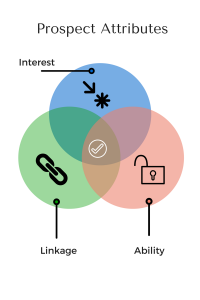Surefire Ways to Identify Your Major Gift Prospects, Part 1

Going from an innocuous list of people in your database to a select list of top prospects is not difficult, but it does require discipline in an orderly process to distinguish who can be a leader, who has the interest in your cause and who has the wealth to make a difference. In the fundraising profession, this process involves discovering linkage, interest and ability.
As the profession has matured since the late 1950’s, statistics show that the majority of dollars raised for an organization are coming from a small percentage of the donor base. Italian economist Vilfredo Pareto did some studies in the late 1800’s and noticed that 80 percent of productivity was determined by 20 percent of the population
This was adopted early in fundraising’s history to suggest that 80 percent of the money would come from 20 percent of your donors. That has changed through the 1990’s and 2000’s – many organizations find that 90 percent or even 95 percent of donations are coming from 5 to 10 percent of donors. This is even truer when it comes to a capital campaign or any dedicated and focused major gift initiative.
Plan to Uncover & Identify
What should be our plan of attack to uncover the 5 or 10 percent of donor prospects that we will want to enlist to serve our mission? We will start with a small group of informed leaders who will form something like a focus group – they will be the persons vetting a list of prospective donors and rating them on the basis of the aforementioned criteria – linkage, interest and ability.
Foremost, everyone in the group needs to understand that this is a confidential process; we may be talking about some dirty laundry that is essential to hang in the open because we are looking for the best prospects and there may be some issues our organization does not want to deal with.
We don’t want to tax our focus group volunteers too much, so perhaps 30-40 names per session is enough, given that they will have six objectives.
- How do we know the prospects, who is the right person to contact them and what do we think is the extent of their networks?
- Is this person philanthropic, are there touch points between proven giving and our mission, do we believe we can interest this person in our mission?
- What is the person’s history of giving in terms of amounts; could we expect a major gift (size to be determined) from this prospect (individual/corporation/foundation/trust, etc.)?
- Are there special factors that would differentiate a prospect from the crowd? For instance, in a capital campaign CDS conducted, the prospect was not wealthy but knew many wealthy and influential people in the community and could get us appointments with other prospects. He got an extra point or two.
- What are the anecdotes, impressions, feelings, history, rumors and beliefs that surround the individual?
- Who is the best person in our organization to continue developing a close relationship?

Create a Rating System
Using the information gathered from the above objectives/questions, you are creating a rating system. We suggest creating a grid, such as in an Excel spreadsheet. Since this is not science but best thinking, we want to rate in two general categories: linkage and interest equal accessibility, and then capacity to make a significant gift.
Here’s a suggestion:
Rate your prospects with 1 through 5 for linkage, interest and capacity to give, with 5 being the highest. Your best prospects will have a cumulative rating score of 15, 14,13,12, etc.
When you create your spreadsheet, have the first column available to insert your cumulative rating. When you sort it, you’ll have all of your top-rated prospects right in front of you, followed by the lesser-rated prospects. Your spreadsheet now has six columns – first, cumulative rating, next linkage rating, then interest rating, then wealth rating, some anecdotal information, and finally, the best person to be the relationship manager.
Now the hard part. Focus on your top prospects, especially those who got a high rating for wealth. This is where your money is. We anticipate that the 15, 14 and 13 rated prospects will be the easiest, fastest and most fulfilling respondents. Other prospects shouldn’t be far behind. Please don’t make the mistake of giving up on those top prospects – remember, that is where the money is according to Pareto and more recent history.
So much of fundraising comes down to belief. Trust the system of the rating process, follow through on your top prospects, don’t lose faith or hope that they will support your mission, and you will create success.
D.C. Dreger, ACFRE is a Vice President at Custom Development Solutions (CDS). He has over 30 years experience as a fundraising and organizational development professional. He can be reached at dc.dreger@cdsfunds.com.